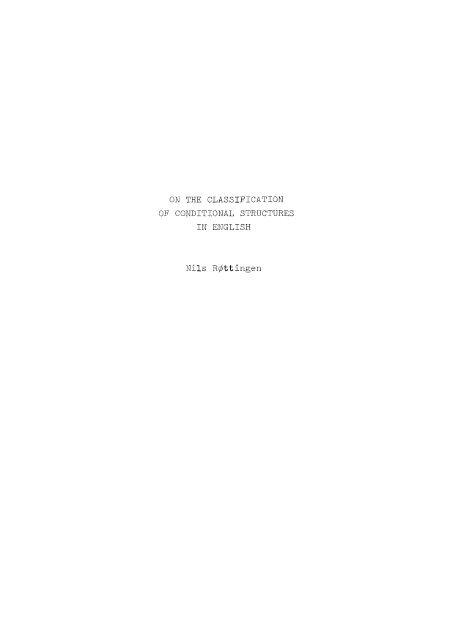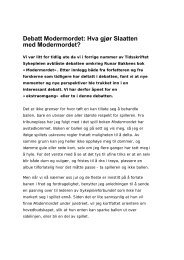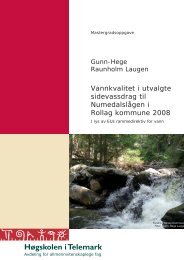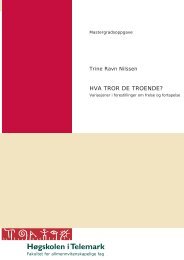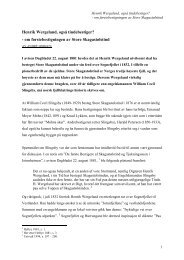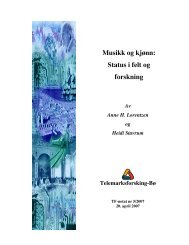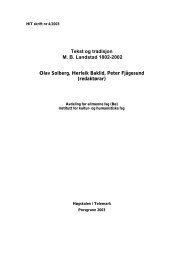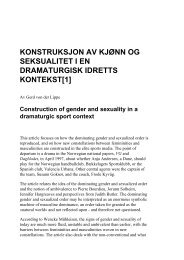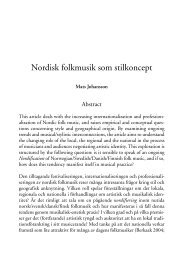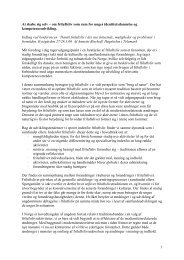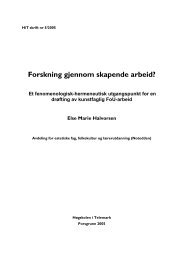ON THE CLASSIFICATION OF CONDITIONAL ... - TEORA
ON THE CLASSIFICATION OF CONDITIONAL ... - TEORA
ON THE CLASSIFICATION OF CONDITIONAL ... - TEORA
Create successful ePaper yourself
Turn your PDF publications into a flip-book with our unique Google optimized e-Paper software.
<strong>ON</strong> <strong>THE</strong> CLASSIFICATI<strong>ON</strong><br />
<strong>OF</strong> C<strong>ON</strong>DITI<strong>ON</strong>AL STRUCTURES<br />
IN ENGLISH<br />
Nils RØttingen
<strong>ON</strong> <strong>THE</strong> CLASSIFICATI<strong>ON</strong> <strong>OF</strong> C<strong>ON</strong>DITI<strong>ON</strong>AL STRUCTURES<br />
IN ENGLISH<br />
HOVUDFAGSOPPGAVE I ENGELSK<br />
Nils RØttingen<br />
Bergen 1972
PREFACE<br />
C<strong>ON</strong>TENTS<br />
l, • • • • • • • • • • • • • • • • • " • • • • • • • • • • • • • • • "<br />
INTRODUCTI<strong>ON</strong> l<br />
Ch. l A SURVEY <strong>OF</strong> <strong>THE</strong>ORIES <strong>OF</strong> CLASSIFICATI<strong>ON</strong><br />
\4ITH COfvII'
C<strong>ON</strong>CLUSI<strong>ON</strong><br />
2.6 Verbal Pa€terna Viaualizing<br />
theDefinitions 61<br />
2.7 Modified Definit10ns Baaed on<br />
'Central Patterna' Il • Il Il • • • .. • .• • • 6;'<br />
BIBLIOGRAPHY<br />
e. Il • • .. • • • ._ • • • • .. • • .. .. • • .. .. • .. Il ol Il • Il Il Il<br />
• Il' Il Il • • • • • .. Il .- Il • • Il Il Il • Il • Il, Il • • Il • Il • 71<br />
vi
(2) those which imply non-fulfilment of the<br />
condition, or at least that fulfilment is<br />
(or was) unlikely (clauses of rejected condition).<br />
If I had time I should be pleased to go too.<br />
If I had had time I should have been p1eased<br />
to go too. (§ 2310)<br />
The definitions are clearly semantic-based, there<br />
being no reference at all to formal characteristics. Still,<br />
Kruisinga, like Onions, must be praissd for having aaded a<br />
fairly detailed description of the different verbal forms<br />
occurring in saah cla8s. His disaussion is not sxhaustive<br />
but he has at least tried to give praatical signifiaance to<br />
his semantia-based definitions by drawing attention to formal<br />
manifestations. Like Sweet, Onions and Poutsma he has<br />
ignored hypothetia conditions.<br />
1.6 G• O Curme<br />
G.O. curme , in his Grammar of the English Language,<br />
deviates from the grammarians treated 60 far, first of all,<br />
by introducing a new terminology. He adheres, however, to<br />
the traditional proaedure: semantic-based deflnitions of the<br />
different elasses followed by a survey of verbal forms as<br />
of the apodoses differ: in (i) the imperativa is used, in<br />
(ii) the conditional is employed. Nevertheless, in spite of<br />
this justification, the!r classifications cannot be accepted:<br />
(i) is an uncertain condition, (ii) should be classified as<br />
a hypothetic condition. This will be further illuminated in<br />
the following chapter.<br />
8
we usa the subjunative. This attitude of mind waa<br />
more common in older English, 80 that the sUbJunotive<br />
here was more common then. (p. 422)<br />
This notional definition is certainly rather vague<br />
and to some extent superfluous because, in a following chapteri<br />
9
speaking, tbis arrangement should ratber bave been the r ••ult<br />
of the analyais wbiah can be studied in a tollowing section.<br />
In praatiee this was also what happened: the different<br />
stnøctures .ere jotted down .s they appeared in the corpus;<br />
th&;t!'the material vas investigated and arranged, the outoome<br />
of this inv.stigation being the following list of conditional<br />
structures. Finally, it might be added that the principles<br />
governing the choice and number of examples inserted under<br />
each pattern have been those of economy of presentation:<br />
not more than five examples have been given unless these<br />
would fail to exemplify all recorded structures, and faithful<br />
reproduation of the observational data: all types of the<br />
examples aolleated have been inaluded.<br />
I<br />
2.2 A List of Verbal Struatures<br />
l P: The simple present tensel indicative<br />
A: The simple present tense indiaativ.<br />
Examples: (44 examples found).<br />
If I get more, I am sure it is my duty, and it<br />
ahall be my oare, to love and cherish you both.•..<br />
(p. 2)<br />
•.•and then you seem 80 full of joy at his goddness,<br />
sa taken with his kind expressions, (whieh, truly,<br />
lThe term the simple present tense is used in<br />
concr-ast to theexpanded Eresent temae (I.e. the present<br />
tense of BE + the present partic!pl€l), the structures<br />
oan, do (does), may, muet, need (+ the plain infinitive),<br />
----- ---
••• "out, if you can eolleet from it any other<br />
cireumstances, I might hope I shou1d not be the<br />
worle treatad." (p. 355)<br />
Wou1d it not look al if I was prepossessed, as<br />
he calls it, if I don't oblige him •••• (p. 224)<br />
Said my master, "I would have it to-morrow, or<br />
the next day at farthelt, if Pamela will•••• CP. 288)]<br />
3 P: Can l muet 2 ahaIl) \1111 (+- the Elain infinitiv.)<br />
A: The imperative<br />
Examples: (19 examEles found).<br />
"but if you can find an exeuse for it, let<br />
her come in.l! (p.43)<br />
••• but, if I must suffer, let me not be lang<br />
a mournfu1 survivorL (p. 173)<br />
- O keep me, heaven, from their high condition.<br />
if my mind shall ever be taint.d with the!r vice,<br />
or polluted with 80 eruel and ineonsiderate a<br />
eontempt of that humble estate they behold with<br />
sa mueh seorn! (p. 229)<br />
••• but let her stand, if she will. (p. 22)<br />
4 P: Can, do (daes) + the pl.ih infinitiv.<br />
A: The passive voiee present ten!.<br />
Examplea: (i examEles found) •<br />
••• and I am undone, to be sure) if God does<br />
not proteet m••••• (p. 97)<br />
••• but am not discouraged by this ill suee.ss,<br />
let what will come of it, if I can serve you.<br />
(p. 117)<br />
20
xv<br />
2 P: The past tanse of BE + the pre12ositional infinitive<br />
A: May, shallllwi11 • the plaininfinitiv!,.<br />
Examples: (3 examp1es found) •<br />
••• for, perhaps, this new oondition may be<br />
subjeob to still woree h.gards than those I<br />
have escaped; should coneeitadnase, vanity,<br />
and pride, take hold of my frail heartj and<br />
if I was 1l for my sd.ns , to be ..left to my own<br />
conduct, a frail bark in a tempestuous ocean,<br />
without ballast, or other pilot than my own<br />
inconsiderate will. (p. 297)<br />
But, having nothing elae to do, and I am sure<br />
I 8ha11 not eleep a wink to-night, if I was to<br />
ga to bed, I will write my time away •..• (p. 216)<br />
'" I would not, for any consideration, that you<br />
should believe rne capable of receiving negligently<br />
an honour, that all the duty of a lang life, were<br />
it to be lent me, will not be sufficient to enable<br />
me to be grateful for. (p. 291)<br />
l P: The simple past tanse or did (+ the plain<br />
infinitive). Aotion.l charaoter l of the verb:<br />
Eerfective / inlStantaneous /<br />
A: Could" might I should, would (+ the 121ain infinitive)<br />
Examples: (18 examples found) .<br />
••• and if she wlnt to bed, instead of 50ribbling,<br />
aha could not sleep. (p. 298)<br />
lOccasionally the actional character of the verb<br />
roay be imperfective/durative/. Howøver, the verb may be<br />
modified by an adverb having the faoulty of rendering the<br />
verbal phrase (i.e. verb + adverb) perfective/instantaneous/.<br />
37
arranging the different structures within .ach clas8 from<br />
1 - CD on the basis of frequency. In this way the following<br />
statisties have been established:<br />
RELIABLE C<strong>ON</strong>DITI<strong>ON</strong> (411 examJ21es)<br />
STRUCTURAL I VERBAL STRUCTURES 'VERBAL STRUCTURES NUMBER <strong>OF</strong><br />
SYMBOLS USED IN <strong>THE</strong> USED IN <strong>THE</strong> EXAMPLES<br />
PROTASIS APODOSIS RECORDED<br />
64
1V 3<br />
REL1ABLE C<strong>ON</strong>DITI<strong>ON</strong> continued:<br />
has taken [you]take 3<br />
. lIll l.S taken takes 2<br />
111 3<br />
VI 2<br />
1 6<br />
11 6<br />
1I 7<br />
is taken [you] take 2<br />
is to take will take 2<br />
takes why should l<br />
wiII take did l<br />
\Alil l take why should l<br />
lVI has taken takes l<br />
IV 4<br />
IV S<br />
IV 6<br />
has taken is taken l<br />
has taken has taken l<br />
has taken v(ny should l<br />
V has been taken will take l<br />
VI 3<br />
is to take took l<br />
VII is going to take will take l<br />
VIII 2<br />
VIII 3<br />
VIII 5<br />
took will take l<br />
took [you] take l<br />
took why should l<br />
IX did will take l<br />
X was to take took 1
UNCERTAIN C<strong>ON</strong>DITI<strong>ON</strong> (111 axamples)<br />
STRUCTURAL VERBAL STRUCTURES VERBAL STRUCTURES NUI"1BER <strong>OF</strong><br />
SYlVIBOLS USED IN <strong>THE</strong> US ED IN <strong>THE</strong> EXAMPLES<br />
PROTASIS APODOSIS RECORDED<br />
I<br />
XI should (take) "!flill (take) 36<br />
2<br />
XII 2<br />
XIII 2<br />
XI l<br />
be \-'lill (take )<br />
take t rp will (take ) I 10<br />
should (take) takes 9<br />
XIII be takes 8<br />
XII 3<br />
XI 3<br />
be [you] take 7<br />
should (take) [you] take 5<br />
XlIII take + rp I takes 3<br />
I<br />
XIV 2<br />
XI 4<br />
XI 5<br />
XII 4<br />
XIII 3<br />
XIII 4<br />
I<br />
was to take will take 3<br />
should take is taken l<br />
should take has taken l<br />
be has taken l<br />
take + rp [you] take l<br />
take + rp is to take l<br />
XlVI was to take takes l<br />
I<br />
24
and transformationalist's large$t unit of grammatioal<br />
descriptioD. could not aOftvey the relevant information.<br />
Thus the present approach deviates from the<br />
traditionalist's insistenae upon semantics as constituting<br />
the basic oriterion in language studies but a180, to some<br />
extent, from the early structuralist ts rigorous rejection<br />
of meaning as being altogether incompatible with a<br />
scientific investigation of language. The form and distri<br />
bution of the linguistic units must be considered the basic<br />
criteria in linguistic analyses; bow.ve'i-, semant Lc s can<br />
provide useful insights lnto language structure, and should<br />
thus be consulted when formal characteristics attach<br />
identical lab81s to structures whieh the intuitive knowledge<br />
of language tells us should be treated as separate eat.gories.<br />
70


